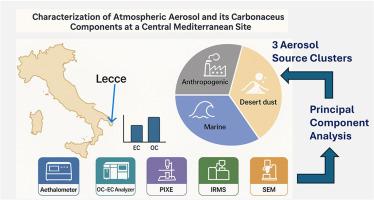地中海中部站点大气气溶胶及其碳质成分的特征:使用光学、物理和同位素技术的多方法方法
IF 3.4
Q2 ENVIRONMENTAL SCIENCES
引用次数: 0
摘要
在2024年5月至6月的监测活动中,采用了一种新的分析方法,结合了乙醇计测量、有机碳和元素碳(OC/EC)分析、扫描电子显微镜(SEM)、粒子诱导x射线发射(PIXE)和同位素比质谱(IRMS)来表征位于地中海中部的莱切(意大利)的气溶胶特性及其碳质成分。人为活动(如车辆交通、工业排放)和自然事件(如野火、沙漠沙尘输送)都是造成研究地点大气气溶胶光学、物理和化学性质高时间变异性的原因。更详细地说,测量的吸收Ångström指数(AAE)平均值(在1.0-1.5范围内)表明黑碳和有机或生物颗粒的混合物。气溶胶吸收系数和PM质量浓度之间的相关分析强调了EC与OC之间的更强关系,强调了EC在大气气溶胶吸收特性中的作用。通过扫描电镜和PIXE进行化学表征,确定了三种气溶胶源簇:人为(高浓度C,燃烧源和工业排放的标志)、沙漠尘埃(地壳元素)和海洋喷雾(Na和Cl)。IRMS同位素分析进一步证实了人为和自然气溶胶源之间的区别,在受自然活动和人为活动影响的海洋气溶胶中观测到重叠。这项工作强调了了解气溶胶组成和动力学的多方法程序的重要性,并与空气质量监测、气候建模和健康风险评估有潜在的联系。本文章由计算机程序翻译,如有差异,请以英文原文为准。

Characterization of atmospheric aerosol and its carbonaceous components at a central Mediterranean site: A multi-method approach using optical, physical, and isotopic techniques
A new analytical approach combining aethalometer measurements, organic and elemental carbon (OC/EC) analysis, Scanning Electron Microscopy (SEM), Particle Induced X-ray Emission (PIXE), and Isotope Ratio Mass Spectrometry (IRMS) was used to characterize aerosol properties and its carbonaceous component in Lecce (Italy), located in the Central Mediterranean, during a monitoring campaign between May and June 2024. Both anthropogenic activities (e.g., vehicular traffic, industrial emissions) and natural events (e.g., wildfires, desert dust transport) were responsible for the high temporal variability of optical, physical, and chemical properties of atmospheric aerosol at the study site. In more detail, the measured Absorption Ångström Exponent (AAE) mean values (in the range 1.0–1.5) indicated a mixture of black carbon and organic or biogenic particles. Correlation analyses between aerosol absorption coefficients and PM mass concentrations highlighted a stronger relationship with EC compared to OC, highlighting the role of EC in the absorption properties of atmospheric aerosols. Chemical characterization through SEM and PIXE identified three aerosol source clusters: anthropogenic (high C concentrations, markers of combustion sources and industrial emissions), desert dust (crustal elements), and marine spray (Na and Cl). IRMS isotopic analysis further confirmed the distinction between anthropogenic and natural aerosol sources, with overlaps observed for marine aerosols influenced by both natural and anthropogenic activities. This work underlines the importance of multi-method procedures in understanding aerosol composition and dynamics, with potential associations for air quality monitoring, climate modeling, and health risk assessments.
求助全文
通过发布文献求助,成功后即可免费获取论文全文。
去求助
来源期刊

Atmospheric Environment: X
Environmental Science-Environmental Science (all)
CiteScore
8.00
自引率
0.00%
发文量
47
审稿时长
12 weeks
 求助内容:
求助内容: 应助结果提醒方式:
应助结果提醒方式:


